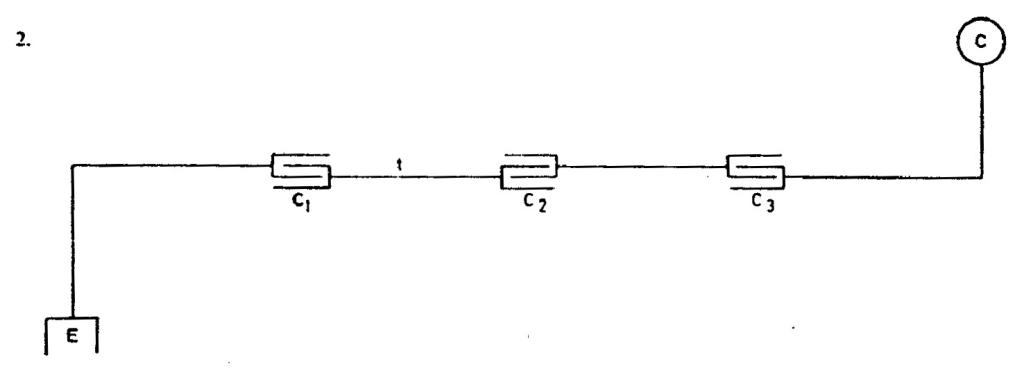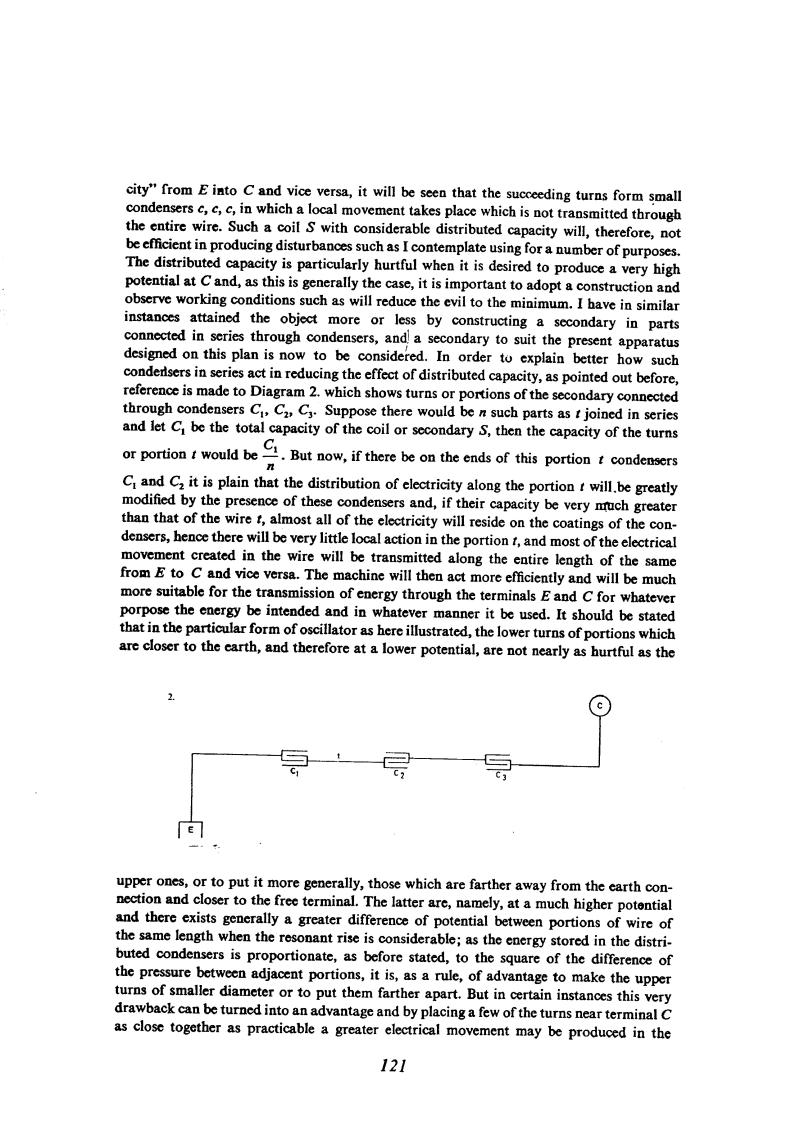
Nikola Tesla Books
cityâ from E into C and vice versa, it will be seen that the succeeding turns form small condensers c, c, c, in which a local movement takes place which is not transmitted through the entire wire. Such a coil S with considerable distributed capacity will, therefore, not be efficient in producing disturbances such as I contemplate using for a number of purposes. The distributed capacity is particularly hurtful when it is desired to produce a very high potential at C and, as this is generally the case, it is important to adopt a construction and observe working conditions such as will reduce the evil to the minimum. I have in similar instances attained the object more or less by constructing a secondary in parts connected in series through condensers, and a secondary to suit the present apparatus designed on this plan is now to be considered. In order to explain better how such condensers in series act in reducing the effect of distributed capacity, as pointed out before, reference is made to Diagram 2. which shows turns or portions of the secondary connected through condensers C1, C2, C3. Suppose there would be n such parts as t joined in series and let C1 be the total capacity of the coil or secondary S, then the capacity of the turns or portion t would be $! {C_{1} \over n} $!. But now, if there be on the ends of this portion t condensers C1 and C2 it is plain that the distribution of electricity along the portion t will be greatly modified by the presence of these condensers and, if their capacity be very much greater than that of the wire t, almost all of the electricity will reside on the coatings of the condensers, hence there will be very little local action in the portion t, and most of the electrical movement created in the wire will be transmitted along the entire length of the same from E to C and vice versa. The machine will then act more efficiently and will be much more suitable for the transmission of energy through the terminals E and C for whatever propose the energy be intended and in whatever manner it be used. It should be stated that in the particular form of oscillator as here illustrated, the lower turns of portions which are closer to the earth, and therefore at a lower potential, are not nearly as hurtful as the upper ones, or to put it more generally, those which are farther away from the earth connection and closer to the free terminal.
The latter are, namely, at a much higher potential and there exists generally a greater difference of potential between portions of wire of the same length when the resonant rise is considerable; as the energy stored in the distributed condensers is proportionate, as before stated, to the square of the difference of the pressure between adjacent portions, it is, as a rule, of advantage to make the upper turns of smaller diameter or to put them farther apart. But in certain instances this very drawback can be turned into an advantage and by placing a few of the turns near terminal C as close together as practicable a greater electrical movement may be produced in the
121
July 31
Tesla made the capacitors for primary circuit from mineral water bottles filled with a saturated solid salt solution. He then submerged several bottles in a metal tank filled with the same solution. By that method he obtained the capacitor groups with a common layer. Other layers (electrolyte in jars) could have been connected in parallel as desired. The least capacitance change of capacitor battery of this type amounted to exactly the capacitance of one jar. By performing the withstand tests on such capacitors at a frequency of 144 Hz he concluded that they could withstand even 30,000 volts when two series of them are connected in series. By so solving the capacitor problems in primary circuit, he returns again to the secondary circuit. In the secondary he hadn't yet solved the problem of coil distributed capacitance, in which he sees the main obstacle on the way of achievement of desirable high voltages. Tesla's analysis, somewhat strange for a reader of these days (sometimes even incorrect) as hosed on a limited number of facts, impressed with its breadth. Tesla deeply penetrates in physical processes, and attempts to understand what and how something happens. His experiments provide him with proofs for conclusions he came to on the basis of thinking and analysis of previous experiments.
By having a desire to design the secondary coil with minimal self-capacitance, and which will be able to operate at extraordinary high voltages, Tesla devoted his time, more than anybody else before him, to a study of coils. The results were not lacking (coil shapes, winding methods), but with all that Tesla was not satisfied. He thinks what would happen when he would add series capacitors, and what would happen if he could change the distance between windings, or the wire diameter, etc.


